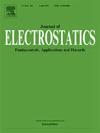Study of the propagation process of electrostatic discharge caused by charged particles
IF 2.1
4区 工程技术
Q3 ENGINEERING, ELECTRICAL & ELECTRONIC
引用次数: 0
Abstract
Chemically processed particles are prone to collide with and friction against metals, which results in charge transfer. The strong electric field that is created breaks down the air and generates electrostatic discharge (ESD), which compromises production safety. The electrostatic field model can judge only whether the electric field strength reaches the breakdown threshold and cannot be used to determine the development process of electrostatic discharge. In this work, the growth process of an electrostatic discharge tree during the accumulation of charged particles is studied via the phase-field model. The propagation process of electrostatic discharge is simulated from a microscopic point of view, and the morphology and regional size of electrostatic discharge are obtained. The air breakdown caused by the strong electric field created by the surface charge density is used to model the propagation process. The bifurcation shape and propagation path of the electric tree match those of earlier studies, confirming the accuracy of the model. The electrostatic discharge tree produced by the side and bottom walls of the metal cylinder is simulated after the ideal mesh size and radius have been established. The findings demonstrate that in ESD, the two-dimensional model is unable to replace the three-dimensional model. Conical and inclined heaps are more likely to produce ESD under the same surface charge density. This work offers a useful model for examining the three-dimensional propagation of ESD.
带电粒子引起的静电放电传播过程的研究
经过化学处理的颗粒很容易与金属发生碰撞和摩擦,从而导致电荷转移。产生的强电场会破坏空气并产生静电放电(ESD),从而影响生产安全。静电场模型只能判断电场强度是否达到击穿阈值,不能用于确定静电放电的发展过程。本文通过相场模型研究了带电粒子积累过程中静电放电树的生长过程。从微观角度模拟了静电放电的传播过程,得到了静电放电的形态和区域尺寸。利用表面电荷密度产生的强电场引起的空气击穿来模拟传播过程。电树的分岔形状和传播路径与前期研究相符,证实了模型的准确性。在确定理想的网格尺寸和半径后,对金属圆柱体侧壁和底壁产生的静电放电树进行了模拟。研究结果表明,在ESD中,二维模型无法取代三维模型。在相同的表面电荷密度下,锥形堆和倾斜堆更容易产生静电放电。这项工作为研究静电放电的三维传播提供了一个有用的模型。
本文章由计算机程序翻译,如有差异,请以英文原文为准。
求助全文
约1分钟内获得全文
求助全文
来源期刊

Journal of Electrostatics
工程技术-工程:电子与电气
CiteScore
4.00
自引率
11.10%
发文量
81
审稿时长
49 days
期刊介绍:
The Journal of Electrostatics is the leading forum for publishing research findings that advance knowledge in the field of electrostatics. We invite submissions in the following areas:
Electrostatic charge separation processes.
Electrostatic manipulation of particles, droplets, and biological cells.
Electrostatically driven or controlled fluid flow.
Electrostatics in the gas phase.
 求助内容:
求助内容: 应助结果提醒方式:
应助结果提醒方式:


